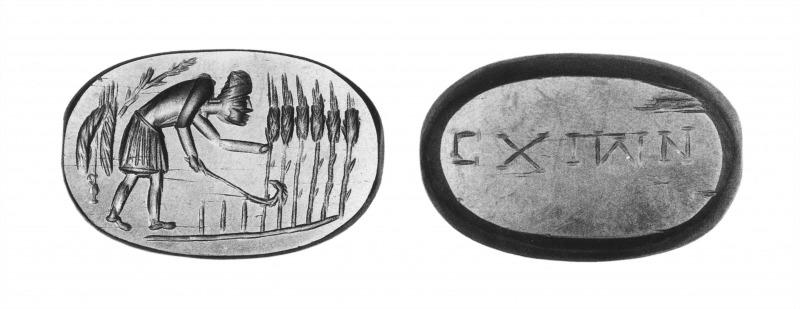Bonner, SMA, 72.
and since that was for a long time not understood, their purpose remained obscure.12 A reaper is bending to his work, cutting several stalks of grain with a long-handled sickle; a few stubbles of the cut stalks stand in front of the reaper. Behind him is a tree. The man wears a tunic belted at the waist and forming a kind of kilt reaching to his knees; a conical cap covers his head. Variations from this type are trivial (D. 115–125). On some specimens it is doubtful whether the upper part of the reaper's body is clothed; the kilt or apron may be the only garment. On one stone the cap seems to have a long vizor.13 On others the man is wearing leggings.14 The number of grain stalks is three, five, or six. In one or two specimens the design is enclosed by the ouroboros, the snake holding the end of his tail in his mouth,15 and in one example the reaper seems to be standing on a snake which does not encircle the whole design but merely serves as a ground line.16 In several of the stones something hangs from a limb of the tree, perhaps the reaper's outer garment.
In all but a few of these stones the reverse bears the inscription σχιων, sometimes spelled σχιον, sometimes accompanied by one or more magical signs or characters.17 The word puzzled the editors not a little, but it is simply a beheaded or aphaeretic form of ἰσχίων, “for the hips”; the genitive is like that previously noted in στομάχου, “for the stomach.” There was a tendency, which began in classical times and became more marked later, to pronounce an unaccented vowel lightly before sigma followed by a mute; and, not unnaturally, the uncertainty about this weak initial syllable sometimes led not only to the omission of the vowel where it belonged but also to the introduction of a vowel where it had no place. One may compare the doublets ἀσπάλαξ, σπάλαξ, and ἀσταφίς, σταφίς, the late occurrence of such forms as σχάς, σχάδιον for ἰσχάς, ἰσχάδιον; σχάρα for ἐσχάρα; and the Hesychian gloss ἰσχερῷ ἑξῆς, where the first word is obviously from σχερός.18 Actual evidence for σχίον = ἰσχίον is scanty apart from these amulets; but in the form σκίον the word occurs in a medieval Greek charm,19 and in a Coptic-Greek magical manuscript published by W. H. Worrell a formula for curing hip pains is introduced by the words ϵΤϐϵ ΠϵϹΧΙΟΝ: ΤΟΚΙΜΟΝ,
12 The explanation of the reaper type, which is here presented in full, was given in all essentials, but with fewer specimens to use as illustrations, in a paper read by me before the Archaeological Institute of America, December 30, 1930. It was reported by title only, “The Reaper Design on Gnostic Amulets,” AJA 35 (1931), 58. However, I did not carry out the purpose, then announced, of publishing the study immediately. Mr. Henri Seyrig, who arrived independently at the same interpretation of these stones, published it in his valuable article “Invidiae Medici” in Berytus, I, 10–11, and further confirmed it in Berytus, 2, 50. I have taken account of his contributions to the subject as well as of my own.
13 D. 118. This must be the stone brought from Egypt by Greville Chester, which Longpérier described in a communication to the Société des antiquaires de France (see their Bulletin, 1867, pp. 121 f.).
17 The reverse of a haematite reaper amulet in the University of Michigan (D. 119) is inscribed Σαβαω. One of the two in the De Clercq collection (3488) has the acclamation εἷς θεὸς on the reverse.
18 These phenomena are discussed and illustrated by K. Dieterich, “Untersuchungen zur Geschichte der griechischen Sprache,” Byzantinisches Archiv, I, 29–36.
19 F. Pradel, Griechische und süditalische Gebete, Beschwörungen, usw. (RGVV III, 3), p. 81.
Last modified: 2012-11-05 10:56:20
Link: cbd.mfab.hu/pandecta/1511









